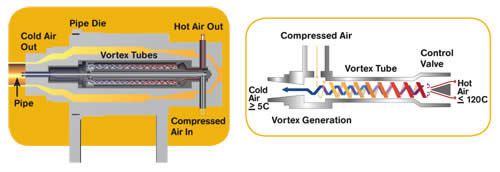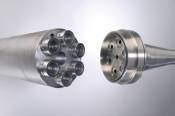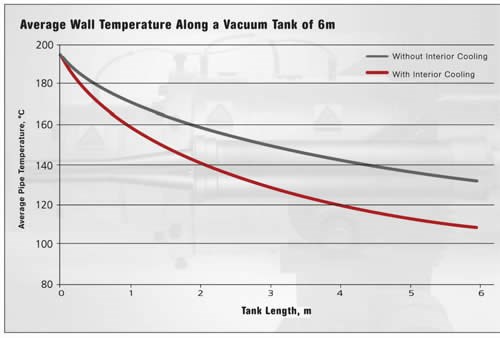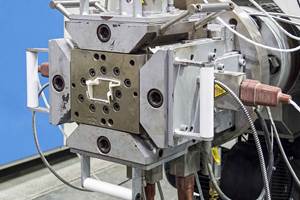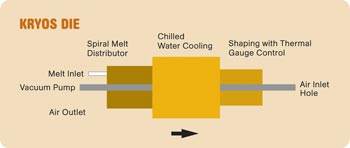Internally Cooled Pipe Die Speeds Output, Reduces Stresses
The recently developed Internal Air Cooling Die from iBA GmbH in Germany substantially increases output of polyolefin pipe or correspondingly reduces the length of downstream cooling, the company says.
The recently developed Internal Air Cooling Die from iBA GmbH in Germany substantially increases output of polyolefin pipe or correspondingly reduces the length of downstream cooling, the company says. Balanced internal and external cooling also produces more uniform temperature through the thickness of the pipe, resulting in lower internal stresses and higher product quality.
Chilled air accomplishes internal cooling in the new die, but it does not require chillers or heat exchangers. Rather, it uses a much more energy-efficient technology based on “vortex tubes.” The vortex tube uses a surprising (but well known) physical phenomenon to divide conventional plant compressed air into separate streams of hot and cold air without any mechanical means, moving parts, or electric power.
This internal die cooling technology is available in this country from Inoex, a sister company to iBA, a developer of specialized technology for pipe dies and downstream cooling. Six of the iBA dies have been delivered since 2007. They range from 63 to 630 mm diam. and are used for PE-80, PE-100 and PP pipe production. The new die increases output of 63-mm pipe up to 32%, 250-mm pipe up to 23%, and 630-mm pipe up to 18%, says iBA president Dr. Joerg Schmuhl, who invented the internal cooling technology.
HOW VORTEX TUBES WORK
The vortex tube is the key to producing cold air from room-temperature shop compressed air. A vortex tube is a narrow, 20:1 L/D tube with small air inlets and outlets at opposite ends. A ring of these tubes is embedded in the die mandrel. The assembly of vortex tubes is insulated to provide thermal isolation from the die mandrel itself.
Compressed air at 6 to 8 bar (85 to 115 psi) and ambient temperature is blown into the vortex tubes. As the air goes up the tube in a spiral flow pattern, the compressed air relaxes and expands. During this relaxation process, hotter air separates from colder air. When the air streams hit the end of the tube, the hot air is taken off via a valve. The cold air reverses direction and goes back down the middle of the tube in a tight counter-spiral inside the spiral of incoming air. According to the physics of this phenomenon, compressed air at ambient temperature divides into about 70% cold air (down to -5 C) and about 30% hot air (up to 120 C). Cold air then leaves the vortex tube and passes through channels to the end of the die where it cools the inside of the emerging pipe. By the time the air exits the cut end of the hot pipe, the air is about 60 C.
Meanwhile, the hot air extracted from the vortex tube is channeled back around the outside of the extruder barrel, where it contributes heat to the extruder, then enters the material hopper and preheats the pellets, saving energy during extrusion.
The iBA internal air-cooling device needs a minimum of four vortex tubes to provide a balanced flow of cold air inside the pipe. For a 63-mm die, the device uses four tubes. For a 630 mm die, it uses up to 16 tubes, which are also larger. IBA is now engineering internally cooled retrofits for dies up to 1600 mm diam. and offers the technology for dies up to 2000 mm. The internal cooling device can be supplied as part of a new pipe die or can be retrofitted into an existing die if internal space allows.
The biggest application so far for iBA’s internal-cooling pipe dies is to maximize output of polyolefin pipe from an existing cooling line. “In this situation, a processor can install a new higher output extruder with the internal air-cooling die and continue to use the same downstream cooling,” notes Andreas Haus, iBA sales manager. “This is especially advantageous for extrusion lines in an existing building, where extending the length of the cooling line isn’t an option.”
Simultaneous cooling of interior and exterior pipe surfaces also improves pipe quality. Pipe shrinkage is more even, and there is less residual stress in the pipe wall.
Inoex first demonstrated iBA’s internal air cooling at an open house in Germany in mid-2008, when a 60-mm, 30:1 L/D extruder made 110-mm diam. HDPE pipe with 8.1-mm wall thickness at 660 lb/hr. The demo used one 9-meter-long vacuum cooling tank, from which pipe emerged with a wall surface temperature of 137 F. Without internal air cooling, pipe surface temperature was 177 F at the end of the tank.
For larger pipe, iBA is developing a combination of very fine water spray with chilled air inside the pipe to increase the rate of heat transfer. This requires very fine mist in order not to cause blisters on the inner surface of the pipe, and the water has to be decalcified first to prevent plugging of small nozzles. IBA expects to have the first air/mist cooling system installed for customer trials by the end of the year. Inoex will show a scale model of the iBA die at NPE in June.
Related Content
Tight-Tolerance Molder Dips Toe in Extrusion Waters
Midwest Precision Molding brings extrusion capacity in-house to assist a customer that was having a sourcing issue with its existing overseas suppliers.
Read MoreNew Rotary Die and Cam Lock Design for Tubing
NPE2024: New design enables quick and easy assembly and disassembly of the crosshead, and eliminates the socket head cap screws.
Read MoreHow to Effectively Reduce Costs with Smart Auxiliaries Technology
As drying, blending and conveying technologies grow more sophisticated, they offer processors great opportunities to reduce cost through better energy efficiency, smaller equipment footprints, reduced scrap and quicker changeovers. Increased throughput and better utilization of primary processing equipment and manpower are the results.
Read MoreIs Your Die Flow Changing Despite Following All the Correct Formulas?
Maybe the problem is that you're starting up with a dry die. Here are tips to solve this issue.
Read MoreRead Next
Air/Water Cooling Die Doubles Output of PE Pipe
A new high-output extrusion die for large HDPE or PP pipe (110 to 2000 mm OD) combines water-cooling of the melt before it leaves the die with air cooling inside the pipe.
Read MoreMaking the Circular Economy a Reality
Driven by brand owner demands and new worldwide legislation, the entire supply chain is working toward the shift to circularity, with some evidence the circular economy has already begun.
Read MoreLead the Conversation, Change the Conversation
Coverage of single-use plastics can be both misleading and demoralizing. Here are 10 tips for changing the perception of the plastics industry at your company and in your community.
Read More



